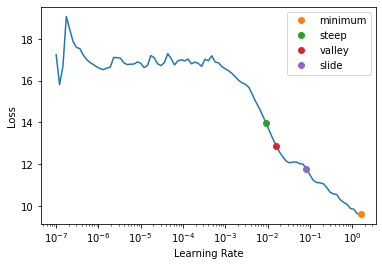from fastai.test_utils import *超参数调度
退火
退火函数 (annealer)
annealer (f)
使 f 返回其部分应用结果的装饰器。
这是我们将用于所有调度函数的装饰器,因为它将接受 (start, end, pos) 的函数转换为接受 (start, end) 并返回一个依赖于 pos 的函数。
指数调度 (sched_exp)
sched_exp (start, end, pos)
常数调度 (sched_no)
sched_no (start, end, pos)
余弦调度 (sched_cos)
sched_cos (start, end, pos)
线性调度 (sched_lin)
sched_lin (start, end, pos)
annealings = "NO LINEAR COS EXP".split()
p = torch.linspace(0.,1,100)
fns = [SchedNo, SchedLin, SchedCos, SchedExp]for fn, t in zip(fns, annealings):
plt.plot(p, [fn(2, 1e-2)(o) for o in p], label=t)
f = SchedPoly(2,1e-2,0.5)
plt.plot(p, [f(o) for o in p], label="POLY(0.5)")
plt.legend();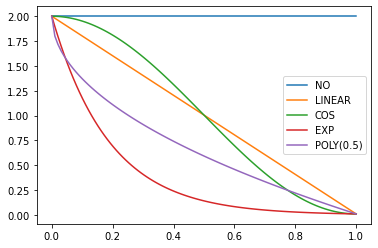
SchedLin
SchedLin (start, end)
从 start 到 end 的线性调度函数
sched = SchedLin(0, 2)
test_eq(L(map(sched, [0., 0.25, 0.5, 0.75, 1.])), [0., 0.5, 1., 1.5, 2.])SchedCos
SchedCos (start, end)
从 start 到 end 的余弦调度函数
sched = SchedCos(0, 2)
test_close(L(map(sched, [0., 0.25, 0.5, 0.75, 1.])), [0., 0.29289, 1., 1.70711, 2.])SchedNo
SchedNo (start, end)
具有 start 值的常数调度函数
sched = SchedNo(0, 2)
test_close(L(map(sched, [0., 0.25, 0.5, 0.75, 1.])), [0., 0., 0., 0., 0.])SchedExp
SchedExp (start, end)
从 start 到 end 的指数调度函数
sched = SchedExp(1, 2)
test_close(L(map(sched, [0., 0.25, 0.5, 0.75, 1.])), [1., 1.18921, 1.41421, 1.68179, 2.])SchedPoly
SchedPoly (start, end, power)
从 start 到 end 的多项式调度函数(power 次)
sched = SchedPoly(0, 2, 2)
test_close(L(map(sched, [0., 0.25, 0.5, 0.75, 1.])), [0., 0.125, 0.5, 1.125, 2.])p = torch.linspace(0.,1,100)
pows = [0.5,1.,2.]
for e in pows:
f = SchedPoly(2, 0, e)
plt.plot(p, [f(o) for o in p], label=f'power {e}')
plt.legend();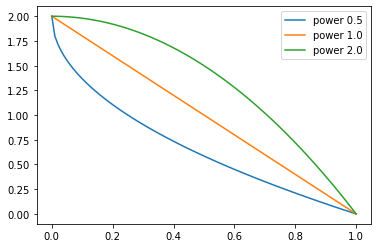
组合调度 (combine_scheds)
combine_scheds (pcts, scheds)
根据 pcts 将 scheds 组合成一个函数
pcts 必须是加起来等于 1 的正数列表,并且与 scheds 长度相同。生成的函数将从 0 到 pcts[0] 使用 scheds[0],然后从 pcts[0] 到 pcts[0]+pcts[1] 使用 scheds[1],依此类推。
p = torch.linspace(0.,1,100)
f = combine_scheds([0.3,0.7], [SchedCos(0.3,0.6), SchedCos(0.6,0.2)])
plt.plot(p, [f(o) for o in p]);
p = torch.linspace(0.,1,100)
f = combine_scheds([0.3,0.2,0.5], [SchedLin(0.,1.), SchedNo(1.,1.), SchedCos(1., 0.)])
plt.plot(p, [f(o) for o in p]);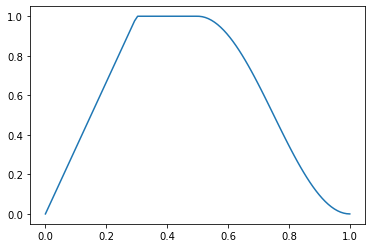
组合余弦调度 (combined_cos)
combined_cos (pct, start, middle, end)
返回一个从 start→middle 和 middle→end 进行余弦退火的调度器
这是针对 1cycle 策略的一个有用辅助函数。pct 用于 start 到 middle 部分,1-pct 用于 middle 到 end 部分。支持浮点数或浮点数集合。例如
f = combined_cos(0.25,0.5,1.,0.)
plt.plot(p, [f(o) for o in p]);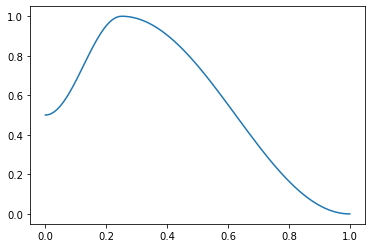
参数调度器 (ParamScheduler)
ParamScheduler (scheds)
根据 scheds 调度超参数
scheds 是一个字典,其中每个你想调度的超参数对应一个键,值可以是单个调度器或调度器列表(后一种情况下,列表长度必须与优化器的参数组数量相同)。
learn = synth_learner()
sched = {'lr': SchedLin(1e-3, 1e-2)}
learn.fit(1, cbs=ParamScheduler(sched))
n = len(learn.dls.train)
test_close(learn.recorder.hps['lr'], [1e-3 + (1e-2-1e-3) * i/n for i in range(n)])| epoch | 训练损失 (train_loss) | 验证损失 (valid_loss) | 时间 |
|---|---|---|---|
| 0 | 11.929138 | 4.039281 | 00:00 |
ParamScheduler.before_fit
ParamScheduler.before_fit ()
初始化超参数容器
ParamScheduler.before_batch
ParamScheduler.before_batch ()
在优化器中设置适当的超参数
ParamScheduler.after_batch
ParamScheduler.after_batch ()
记录此批次的超参数
ParamScheduler.after_fit
ParamScheduler.after_fit ()
如果存在 recorder,将超参数保存到其中
Learner.fit_one_cycle
Learner.fit_one_cycle (n_epoch, lr_max=None, div=25.0, div_final=100000.0, pct_start=0.25, wd=None, moms=None, cbs=None, reset_opt=False, start_epoch=0)
使用 1cycle 策略训练 self.model 共 n_epoch 个周期。
1cycle 策略由 Leslie N. Smith 等人在 Super-Convergence: Very Fast Training of Neural Networks Using Large Learning Rates 中提出。它使用余弦退火策略调度学习率,从 lr_max/div 到 lr_max,然后再到 lr_max/div_final(如果你想使用差异学习率,可以将数组传递给 lr_max),并根据 moms 中的值使用余弦退火调度动量。第一阶段占用训练的 pct_start。你可以选择性地传递额外的 cbs 和 reset_opt。
#Integration test: training a few epochs should make the model better
learn = synth_learner(lr=1e-2)
xb,yb = learn.dls.one_batch()
init_loss = learn.loss_func(learn.model(xb), yb)
learn.fit_one_cycle(2)
xb,yb = learn.dls.one_batch()
final_loss = learn.loss_func(learn.model(xb), yb)
assert final_loss < init_loss| epoch | 训练损失 (train_loss) | 验证损失 (valid_loss) | 时间 |
|---|---|---|---|
| 0 | 19.444899 | 6.755066 | 00:00 |
| 1 | 9.919473 | 1.044571 | 00:00 |
#Scheduler test
lrs,moms = learn.recorder.hps['lr'],learn.recorder.hps['mom']
test_close(lrs, [combined_cos(0.25,1e-2/25,1e-2,1e-7)(i/20) for i in range(20)])
test_close(moms, [combined_cos(0.25,0.95,0.85,0.95)(i/20) for i in range(20)])Recorder.plot_sched
Recorder.plot_sched (keys=None, figsize=None)
learn = synth_learner()
learn.fit_one_cycle(2)| epoch | 训练损失 (train_loss) | 验证损失 (valid_loss) | 时间 |
|---|---|---|---|
| 0 | 5.406837 | 5.305011 | 00:00 |
| 1 | 5.058437 | 4.899223 | 00:00 |
learn.recorder.plot_sched()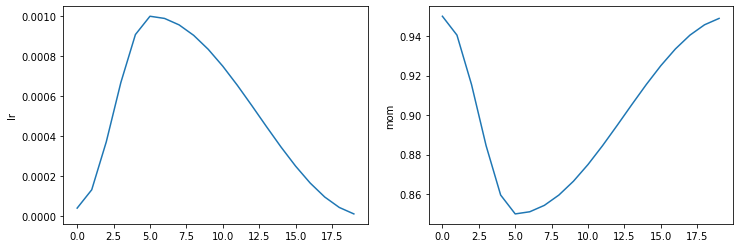
Learner.fit_flat_cos
Learner.fit_flat_cos (n_epoch, lr=None, div_final=100000.0, pct_start=0.75, wd=None, cbs=None, reset_opt=False, start_epoch=0)
在余弦退火之前,以固定的 lr 训练 self.model 共 n_epoch 个周期。
learn = synth_learner()
learn.fit_flat_cos(2)| epoch | 训练损失 (train_loss) | 验证损失 (valid_loss) | 时间 |
|---|---|---|---|
| 0 | 10.588930 | 7.106113 | 00:00 |
| 1 | 8.943380 | 5.016665 | 00:00 |
learn.recorder.plot_sched()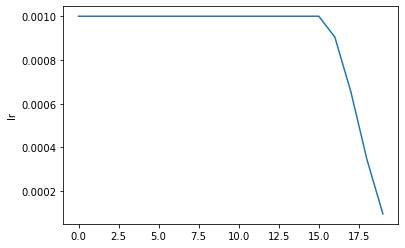
Learner.fit_sgdr
Learner.fit_sgdr (n_cycles, cycle_len, lr_max=None, cycle_mult=2, cbs=None, reset_opt=False, wd=None, start_epoch=0)
使用 SGDR 训练 self.model 共 n_cycles 个周期,每个周期长度为 cycle_len。
该调度策略由 Ilya Loshchilov 等人在 SGDR: Stochastic Gradient Descent with Warm Restarts 中提出。它包含 n_cycles 个周期,每个周期都是从 lr_max(默认为 Learner 的学习率)到 0 的余弦退火过程,其中第 i 个周期的长度为 cycle_len * cycle_mult**i(第一个周期长度为 cycle_len,然后我们在每个周期将长度乘以 cycle_mult)。你可以选择性地传递额外的 cbs 和 reset_opt。
learn = synth_learner()
with learn.no_logging(): learn.fit_sgdr(3, 1)
test_eq(learn.n_epoch, 7)
iters = [k * len(learn.dls.train) for k in [0,1,3,7]]
for i in range(3):
n = iters[i+1]-iters[i]
#The start of a cycle can be mixed with the 0 of the previous cycle with rounding errors, so we test at +1
test_close(learn.recorder.lrs[iters[i]+1:iters[i+1]], [SchedCos(learn.lr, 0)(k/n) for k in range(1,n)])
learn.recorder.plot_sched()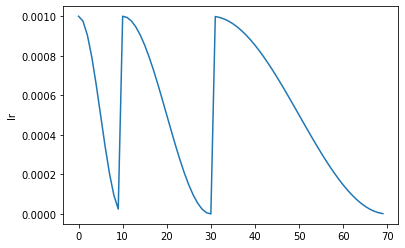
Learner.fine_tune
Learner.fine_tune (epochs, base_lr=0.002, freeze_epochs=1, lr_mult=100, pct_start=0.3, div=5.0, lr_max=None, div_final=100000.0, wd=None, moms=None, cbs=None, reset_opt=False, start_epoch=0)
先使用 Learner.freeze 微调 freeze_epochs 个周期,然后使用 Learner.unfreeze 微调 epochs 个周期,使用差异学习率。
learn.fine_tune(1)| epoch | 训练损失 (train_loss) | 验证损失 (valid_loss) | 时间 |
|---|---|---|---|
| 0 | 2.428970 | 1.740237 | 00:00 |
| epoch | 训练损失 (train_loss) | 验证损失 (valid_loss) | 时间 |
|---|---|---|---|
| 0 | 2.019952 | 1.616970 | 00:00 |
从检查点恢复训练
要启用从检查点恢复,请务必保存模型和优化器状态。这可以通过使用 SaveModelCallback 并设置 (with_opt=True) 来完成。如果训练中断,请使用与之前相同的参数定义 learn,从检查点加载模型,并将 start_epoch 传递给 fit 调用。训练将从 start_epoch 开始,并使用适当调度的 lr 继续进行。
with tempfile.TemporaryDirectory() as d:
learn1 = synth_learner(path=d, cbs=SaveModelCallback(with_opt=True, fname="ckpt"))
learn1.fit_one_cycle(5, cbs=InterruptCallback(2))
learn2 = synth_learner(path=d)
learn2 = learn2.load("ckpt")
learn2.fit_one_cycle(5, start_epoch=2)
fig, axs = plt.subplots(1,2, sharey=True)
axs[0].plot(learn1.recorder.lrs)
axs[1].plot(learn2.recorder.lrs)| epoch | 训练损失 (train_loss) | 验证损失 (valid_loss) | 时间 |
|---|---|---|---|
| 0 | 18.930223 | 14.100439 | 00:00 |
| 1 | 17.092665 | 10.603369 | 00:00 |
Better model found at epoch 0 with valid_loss value: 14.100439071655273.
Better model found at epoch 1 with valid_loss value: 10.603368759155273.| epoch | 训练损失 (train_loss) | 验证损失 (valid_loss) | 时间 |
|---|---|---|---|
| 0 | 00:00 | ||
| 1 | 00:00 | ||
| 2 | 11.456764 | 10.057186 | 00:00 |
| 3 | 10.287196 | 8.694046 | 00:00 |
| 4 | 9.585465 | 8.422710 | 00:00 |
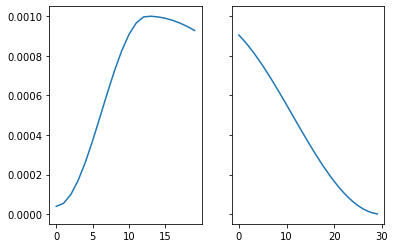
LRFinder
LRFinder (start_lr=1e-07, end_lr=10, num_it=100, stop_div=True)
使用指数增长的学习率进行训练
from fastai.vision.all import *set_seed(99, True)
path = untar_data(URLs.PETS)/'images'
image_files = get_image_files(path)
if sys.platform == "win32" and IN_NOTEBOOK:
image_files = random.choices(image_files, k=int(len(image_files)/8))
print("Randomly select 1/8 files in NOTEBOOK on Windows to save time")
# pickle can't serializer lamda function.
def _label_func(x):
return x[0].isupper()
dls = ImageDataLoaders.from_name_func(
path, image_files, valid_pct=0.2,
label_func=_label_func, item_tfms=Resize(224))
learn = vision_learner(dls, resnet18)
learn.fit(1)
learn.opt.state_dict()['state'][1]['grad_avg']| epoch | 训练损失 (train_loss) | 验证损失 (valid_loss) | 时间 |
|---|---|---|---|
| 0 | 0.086690 | 0.016682 | 00:33 |
tensor([-5.8191e-04, -2.2443e-03, 0.0000e+00, -1.2517e-03, 0.0000e+00,
-1.4744e-03, -3.6433e-04, 0.0000e+00, 9.3745e-03, 0.0000e+00,
5.1993e-03, -1.5093e-02, -4.0410e-03, 0.0000e+00, 7.1963e-03,
-6.6033e-03, -3.3354e-03, -2.9191e-03, -1.5054e-03, -1.3179e-03,
8.7333e-03, -1.1155e-02, -9.6656e-04, 1.6653e-02, 9.5839e-04,
8.4995e-03, -2.8187e-02, 3.1579e-03, -9.3051e-04, -2.3887e-03,
-7.3557e-04, -1.4501e-02, -6.2110e-03, 1.9949e-03, -7.0233e-03,
1.2792e-02, 0.0000e+00, 1.0687e-03, 0.0000e+00, -4.2413e-04,
2.9628e-03, 7.2686e-03, -9.7241e-03, -4.9941e-04, 1.7408e-02,
-9.2441e-03, -9.7731e-03, -9.9393e-03, 0.0000e+00, -2.1448e-03,
2.7660e-03, -3.1110e-03, 5.9454e-05, -1.4412e-03, -6.1454e-04,
-1.6537e-03, 1.7001e-02, 1.4041e-02, -6.2878e-03, 2.0800e-02,
-1.2900e-02, -1.2626e-02, -2.6591e-03, 3.9685e-03], device='cuda:0')with tempfile.TemporaryDirectory() as d:
learn = synth_learner(path=Path(d))
init_a,init_b = learn.model.a,learn.model.b
with learn.no_logging(): learn.fit(20, cbs=LRFinder(num_it=100))
assert len(learn.recorder.lrs) <= 100
test_eq(len(learn.recorder.lrs), len(learn.recorder.losses))
#Check stop if diverge
if len(learn.recorder.lrs) < 100: assert learn.recorder.losses[-1] > 4 * min(learn.recorder.losses)
#Test schedule
test_eq(learn.recorder.lrs, [SchedExp(1e-7, 10)(i/100) for i in range_of(learn.recorder.lrs)])
#No validation data
test_eq([len(v) for v in learn.recorder.values], [1 for _ in range_of(learn.recorder.values)])
#Model loaded back properly
test_eq(learn.model.a, init_a)
test_eq(learn.model.b, init_b)
test_eq(learn.opt.state_dict()['state'], [{}, {}])LRFinder.before_fit
LRFinder.before_fit ()
初始化超参数容器并保存模型
LRFinder.before_batch
LRFinder.before_batch ()
在优化器中设置适当的超参数
LRFinder.after_batch
LRFinder.after_batch ()
记录此批次的超参数并可能停止训练
LRFinder.before_validate
LRFinder.before_validate ()
跳过训练的验证部分
建议方法
有几种自动建议学习率的方法,正如我们将看到的,这些方法可以进一步传递给 lr_find。目前支持四种方法,但是要编写自己的方法,它应该看起来像一个函数,可以接受 LRFinder 返回的 lrs、losses 以及 num_it。你的函数应该返回一个可以绘制的 x,y 坐标,如下所示
def myfunc(lrs:list, losses:list, num_it:int) -> tuple(float, tuple(float,int)):
...
return suggestion, (suggestion,loss_idx)如果还有其他需要传入的参数,你应该将 func 作为 partial 传入并自行指定,例如
def myfunc(lrs:list, losses:list, num_it:int, pct_reduction:float) -> tuple(float, tuple(float,int)):
...
return suggestion, (suggestion,loss_idx)f = partial(myfunc, pct_reduction=.2)valley (波谷)
valley (lrs:list, losses:list, num_it:int)
从最长的波谷建议一个学习率并返回其索引
valley 算法由 ESRI 开发,取 LR 曲线最长波谷约 2/3 处的最陡斜率对应的学习率,也是 Learner.lr_find 的默认方法。
slide (滑动)
slide (lrs:list, losses:list, num_it:int, lr_diff:int=15, thresh:float=0.005, adjust_value:float=1.0)
根据区间滑动规则建议一个学习率并返回其索引
slide 规则是 Andrew Chang 在 Novetta 开发的一种算法,详情见此处。
minimum (最小值)
minimum (lrs:list, losses:list, num_it:int)
建议一个在发散前最小值十分之一处的学习率并返回其索引
steep (最陡)
steep (lrs:list, losses:list, num_it:int)
建议一个斜率最陡峭时的学习率并返回其索引
Recorder.plot_lr_find
Recorder.plot_lr_find (skip_end=5, return_fig=True, suggestions=None, nms=None, **kwargs)
绘制 LR Finder 测试结果(如果您之前没有运行 learn.lr_find() 则无法工作)
Learner.lr_find
Learner.lr_find (start_lr=1e-07, end_lr=10, num_it=100, stop_div=True, show_plot=True, suggest_funcs=<function valley>)
启动模拟训练以寻找合适的学习率,并根据 suggest_funcs 返回命名元组形式的建议结果
LR Finder 最早由 Leslie N. Smith 在 Cyclical Learning Rates for Training Neural Networks 中提出,它通过从 start_lr 到 end_lr 的指数增长学习率训练模型 num_it 次迭代,并在发生发散时停止(除非设置 stop_div=False),然后以对数刻度绘制损失与学习率的关系图。
可以将多种学习率建议算法传递给该函数,默认情况下我们使用 valley 方法。
with tempfile.TemporaryDirectory() as d:
learn = synth_learner(path=Path(d))
weights_pre_lr_find = L(learn.model.parameters())
lr_min, lr_steep, lr_valley, lr_slide = learn.lr_find(suggest_funcs=(minimum, steep, valley, slide))
weights_post_lr_find = L(learn.model.parameters())
test_eq(weights_pre_lr_find, weights_post_lr_find)
print(f"Minimum/10:\t{lr_min:.2e}\nSteepest point:\t{lr_steep:.2e}\nLongest valley:\t{lr_valley:.2e}\nSlide interval:\t{lr_slide:.2e}")Minimum/10: 1.58e-01
Steepest point: 9.12e-03
Longest valley: 1.58e-02
Slide interval: 8.32e-02